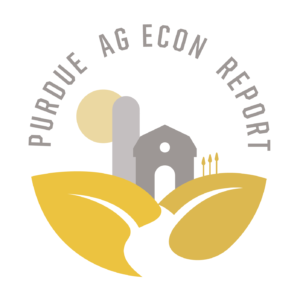Farm Finances: Who Could be In Trouble?
December 23, 2013
PAER-2013-17
Mike Boehlje, Professor
What will be the impacts of lower grain prices on the financial position of Midwest farmers? Most grain farms have exhibited strong financial performance in recent years. Livestock producers who had experienced losses and severe financial stress during the recent period of high feed costs are beginning to recover with declines in corn and soybean meal prices.
Liquidity positions as reflected by the current ratio (current assets divided by current liabilities) and working capital (current assets minus current liabilities) are strong for those who have retained their cash from earnings and not aggressively used it to purchase land or machinery and equipment. Most farmers have been cautious in their use of debt – – debt to asset ratios for the farming sector are close to all-time lows.
The exceptions are farming operations that have been very aggressive in expanding their business through land purchases, and livestock farms who have in many cases had to use borrowed funds to offset large operating losses. Debt repayment ratios have also been strong – – enhanced by record low interest rates as well as strong cash incomes.
To obtain some insight into the future financial vulnerability of grain farmers given the prospects of lower prices and incomes, the financial performance of typical Midwest grain farms was simulated under shocks of volatile crop prices, yields, fertilizer prices, farmland values, and cash rent. Farms of 550, 1200, and 2500 acres were constructed with three different farmland ownership structures (15%, 50%, and 85% of land owned) and two capital structures measured by debt-to-asset ratio (25% and 50%).
The results indicate that farms with modest size (550 acres) with a large proportion of their land rented are quite vulnerable irrespective of their leverage positions. These same modest size farms are more financially resilient if they have a higher proportion of their acreage that is owned rather than rented. These modest size farms with most of their land rented, as is typical for beginning farmers, are the most financially vulnerable.
Larger farms (2500 acres) with modest leverage (25% debt-to-asset ratio) that combine rental and ownership of the land they operate have strong financial performance and limited vulnerability to price, cost, yield, and asset value shocks. And, these farms can increase their leverage positions significantly (from 25% to 50% in this study) with only modest deterioration in their financial performance and a slight increase in their vulnerability.
In general, given the outlook for lower product prices and tighter profit margins in 2014-15, some farmers will face serious financial headwinds. Cash flows will not be as strong as in the recent past, and interest rates are likely to rise modestly (1.0-1.5 percentage points). Lenders will be asking for more evidence and documentation of expected earnings and repayment capacity, and farmers are likely, as they typically do when financial conditions are tougher, to reduce capital expenditures and be more aggressive in negotiating lower prices for inputs including cash rents.
Overall, the majority of grain farmers are believed to be well positioned financially to handle lower incomes during the next few years. However, the key concern at this point is the vulnerability to lower than expected crop prices for a prolonged period or large declines in land values.
